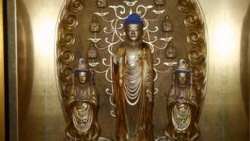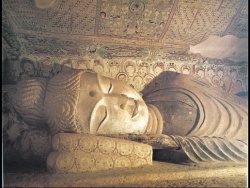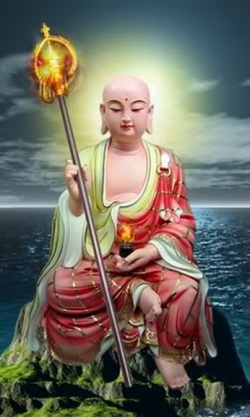The Seven Patriarchs of Jodo-Shinshu Buddhism
Master Shinran singled out seven masters or Patriarchs of Pure Land Buddhism in the millenium prior to his own, beginning with the writings of Bodhisattva Nagarjuna and continuing to his own mentor, Master Honen (Genku).
His own Dharma name, Shinran, is derived from the Japanese spellings of the names of the second Patriarch, Bodhisattva Vasubandhu (seSHIN) and the third Patriarch, Master T'an Luan (DonRAN).
For Shinran the teachings of Shakyamuni Buddha and the Seven Patriarchs are the manifestation of Amida's Compassionate Vow. Shinran's selection of the seven masters is traditionally attributed to the following:
1) Each of the Seven Patriarchs was himself an aspirant for Birth in the Pure Land,
2) Each left writings on the nembutsu teaching,
3) Each of their interpretations is distinguished and essential in the history of the deliverance of the nembutsu.
The Seven Patriarchs eulogized by Master Shinran in his collection of hymns, Koso Wasan, are:
1. Nagarjuna (Jp. Ryuju) (ca 2nd-3rd c. C.E.).
The work of Nagarjuna which is cited in connection with Pure Land Buddhism is the 'Chapter on Easy Practice' in the Ninth Chapter of the Discourse on the Ten Bodhisattva Stages.
In the Easy Path to enlightenment described by Nagarjuna one calls the names of the Buddhas, and he especially singles out calling the name of Amida Buddha.
He quotes the Primal Vow of Amida Buddha as follows:
"If anyone contemplates me, recites my name, and takes refuge in me, he will instantly enter the Stage of Assurance and subsequently attain the highest perfect Bodhi."
In his JUNIRAI, or Twelve Adorations, Bodhisattva Nagarjuna professes his deep devotion to Amida Buddha.
2. Vasubandhu (Jp. Seshin) (ca. 4th cent. C.E.)
Bodhisattva Vasubandhu's contribution to Pure Land Buddhism lies chiefly in his formulation of a nembutsu practice.
He cites five practices for Pure Land birth: Worship of Amida, Praise of Amida, Aspiration for Birth in the Pure Land, Contemplating the Pure Land, and Transferring Merit.
Vasubandu's opening words in his JODORON, or Discourse on the Pure Land, were especially singled out by Master Shinran as fundamental:
"O World-Honored One, I, with single-mindedness, take refuge in the Tathagata whose unhindered Light exhaustively fills the ten quarters and aspire to be born in the Land of Peace and Bliss."
3. T'an-luan (Jp. Donran) (476-542 C.E.)
Master T'an Luan began as a Taoist, but when he was introduced to Pure Land Buddhism by Bodhiruci he burned his Taoist books and embraced complete faith in Amida Buddha.
What is important about Master T'an Luan's contribution to the development of Pure Land Buddhism is:
(1) the single-minded way he set about defining Pure Land practice;
(2) his absolute reliance on the Other Power of Amida Buddha to bring the aspirant to birth and buddhahood in the Pure Land; and
(3) the fact that he turned his devotion into a mass movement.
Master T'an-luan's San Amida Butsu Ge (Gatha in Praise of Amida Buddha) inspired many of Master Shinran's own hymns.
4. Tao-ch'o (Jp. Doshaku) (562-645 C.E.)
Tao-ch'o, revising Nagarjuna's Difficult and Easy Paths by employing T'an-luan's distinction between self-power and other-power, divides the whole of Buddhist teachings into the Sacred Path (a.k.a. the Path of Sages) and the Pure Land Path.
The former leads to attainment in this world by one's own efforts, and the latter to attainment in the Pure Land through the Other Power of Amida Buddha.
He states that no one in the Age of the Last Dharma (Jp. "Mappo") can attain enlightenment by means of the Sacred Path and that only the nembutsu of the Pure Land Path is effective in leading one to Buddhahood.
In his only surviving work, the An Le Chi, ostensibly a commentary on the Contemplation Sutra but really a wide-ranging exposition of Pure Land thought, Master Tao-ch'o attempted mainly to answer criticisms of Pure Land thought and practice, primarily from the Ch'an (Jp. Zen) camp.
For example, the critics asked how simply reciting Amida's name could possibly have such powerful effects.
The answer to this was simple: there is no power inherent either in the reciter or in the words recited.
The power was with Amida Buddha alone, and the power of His Primal Vow was all that was needed to bring the devotee to the Pure Land.
5. Shan-tao (Jp. Zendo) (613-681 C.E.)
Shan-tao's position in the evolution of Pure Land practice is of great importance, for he was the first to isolate utterance of the Name as the nembutsu practice prescribed in Amida's Vow, thus establishing the superiority of vocal nembutsu over other Amida-centered practices, such as contemplation, sutra reading, and ritual worship.
Master Shan-tao's gatha (verses), Kisamboge, is a powerful statement of aspiration for buddhahood through the Other Power of Amida Buddha.
Master Shan-tao's famous Parable of the White Path has remained a treasured fable over the centuries, explaining, in story fashion, salvation by Amida Buddha in the Pure Land.
6. Genshin (a.k.a. Eshin) (942-1017 C.E.)
Genshin is most famous for his treatise, 'Collection on the Essentials for Attaining Birth,' [Jp. Ojoyoshu) which exerted great influence on the popular imagination in the Heian period and became one of the first books to be printed in Japan.
His descriptions of the terrors of hell and the wonders of the Pure Land, aimed at wakening religious aspiration to nembutsu practice, had great influence.
Genshin, like many sages of the Japanese Pure Land tradition, began as a Tendai Buddhist and became devoted to the Nembutsu, or the "calling of the Name" of Amida Buddha (Namu Amida Butsu), as a sole practice (in Tendai Buddhism, the Nembutsu was but one of many self-power practices).
Late in life he founded a small retreat on Mt. Hiei (the location of the main Tendai monastery) called Yokawa, where he taught sole reliance upon Amida Buddha through the Nembutsu of Other Power.
Master Genshin's "Yokawa Hogo" is a succinct expression of his faith in Amida Buddha.
7. Honen (a.k.a. Genku) (1133-1212 C.E.)
The vital role Honen played centers upon his complete rejection of the possibility of effective self-power practice of any kind and his sole reliance on Other Power, i.e. the Power of Amida Buddha's Primal Vow.
With Honen, the unfathomable workings of Amida Buddha's Primal Vow of boundless compassion were brought to life in Japan.
Though he was well versed in the entire Buddhist Canon, Master Honen was awakened at age 43 to the sole practice of Nembutsu recitation after studying Master Shan-tao's writings and the Three Pure Land Sutras.
He went on to form the Jodo-shu sect, and his foremost pupil, Master Shinran, founded Jodo-Shinshu.
Master Honen left seventeen poems, which express his singleminded faith in Amida Buddha and his birth to come in the Pure Land.
When Master Honen was nearing death a follower asked him, "Write me something with your own hand, something which you think will be good for me, in order that I may keep it as a memento."
The result, the famous One-Page Testament of Master Honen, was dictated by him two days before he returned to the Pure Land.




